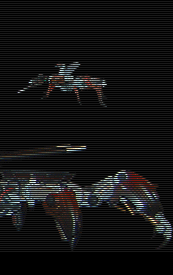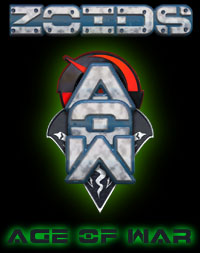PARTS LIST
Killer Dome
Segments, legs, Vulcan cannons, antenna joints and tips, bridge armor, omniped joints, forcipules (mandibles), omniped claws, CWIS cannons, CWIS mounts, communication arrays, bridge gunner controls, main gunlocks, main battery, missile battery and conn array targeting units
Gojulas
command structure, antenna support, omnipeds, hatch handles, engineer station monitors, CWIS articulations, head maintenance hatch
Gorhecks
antennae joints
Gojulas Giga
antenna support, omnipeds, command structure cabling
Mammoth
antenna support array
Dimetra Ptera
command structure, segment hinges
Molga
left forcipule
Kreep
right forcipule
Deathpion
head armor, bridge gunner seats, command substructure, missile turret canopy dome
Black Rhimos
pilot seat, main bridge (motor housing), forcipule supports, mandible supports
Diablo Tiger
primary power structure (battery housing), aft sensor domes (plastic BBs)
Seismosaurus (x2)
command chair, defense guns, command structure, omniped mounts, antenna sensor systems, command substructure auxiliary generators, primary power structure ducting, turret tower details
Elephander (x2)
command conn, lateral bridge armor, turret tower systems
GenoSaurer
bridge lateral defense guns
Ultrasaurus
command structure mount
Berserk Fuhrer
missile battery hinges
Aerosaurer
omniped hydraulics
Death Razer
command structure engineering section (stand)
CP-15 (x2)
missile pods, Gatling cannon
CP-02
Gatling cannon housing, flight deck illumination beacons (sprue)
SUPPORTING CAST
Rebel Snow Speeder
turret tower external details
VS-1S Valkyrie
forcipule cannon
Bic Ballpoint Pens (x26)
primary cannons, sensory antennae, knee joints, omniped thrusters
Hairspray Cap (x2)
turret tower structures
Nylon Hinges
turret hatches, gunner seats, landing pad elevator
Gerwalk Ishkick
bridge control panel
Orguss Nikick
missile structure ventilation unit
USS Missouri
main gun tower power regulators, aft conn defense gun power regulator
HMS Prince of Whales
bridge antennas, segment 4 turret tower detail
Honda Goldwing
bridge primary antenna arrays
Magnum Enforcer Water Pistol
command bridge support structure
CAT-5 Ethernet Cable
main gun hinges, CWIS support structure
Straight Pins
main gun internal supports
Sheet Styrene
turret decks, command structure ventilation tower, communication array arms, flight deck,
CWIS supports, main gun supports, segment articulation armor
Deoderant Cap (x2)
command bridge glass, pilot station glass, omniped armor, omniped thrusters
Video Tape
defense gun decking, command consoles, turret armor
Hoth Rebel Defense Turret
omniped thruster bells
Chirstmas Tree Lights
head, bridge, command conn and landing pad lighting
Zenith Clock Radio
segment #4 turret tower lateral sensor domes
Paneling Nails
omniped hydraulic pistons
SD Gundam
omniped hydraulic systems
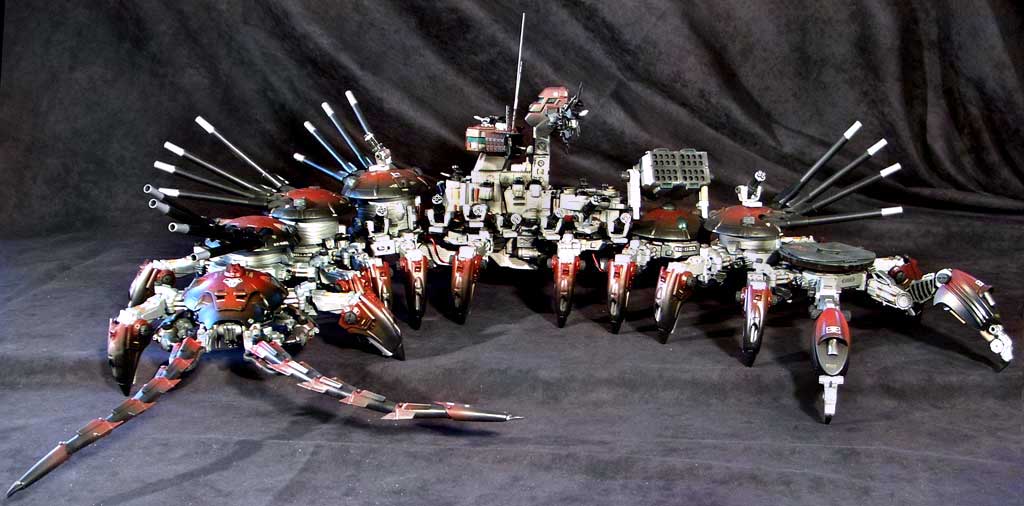
EZ-501 FUSILLADE
Chassis: Centipede
Power Plant: EPZ-XLS (Empire Power Zoid – Extended-Link System, Class-3)
Primary Mission: Indirect Bombardment Platform
Secondary Mission: Theater Command Unit
Crew: 25 (command rank requirement: General)
Statistics
Length: 92.5 meters
Width: 23 meters
Height: 21 meters (16 meters, sans-antennae)
Mass: 550 tons
Performance
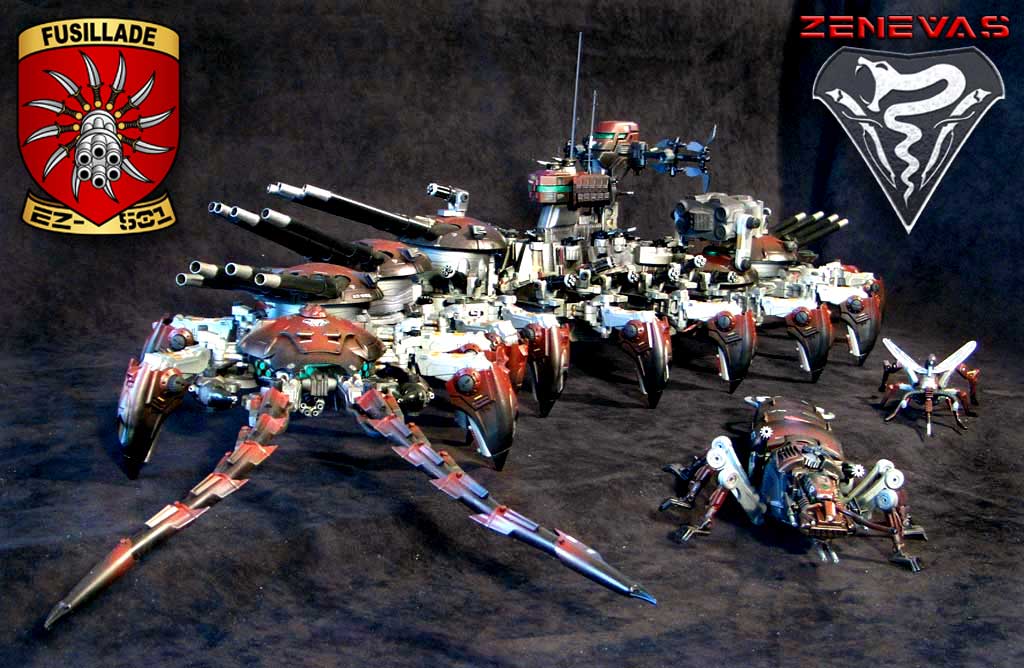
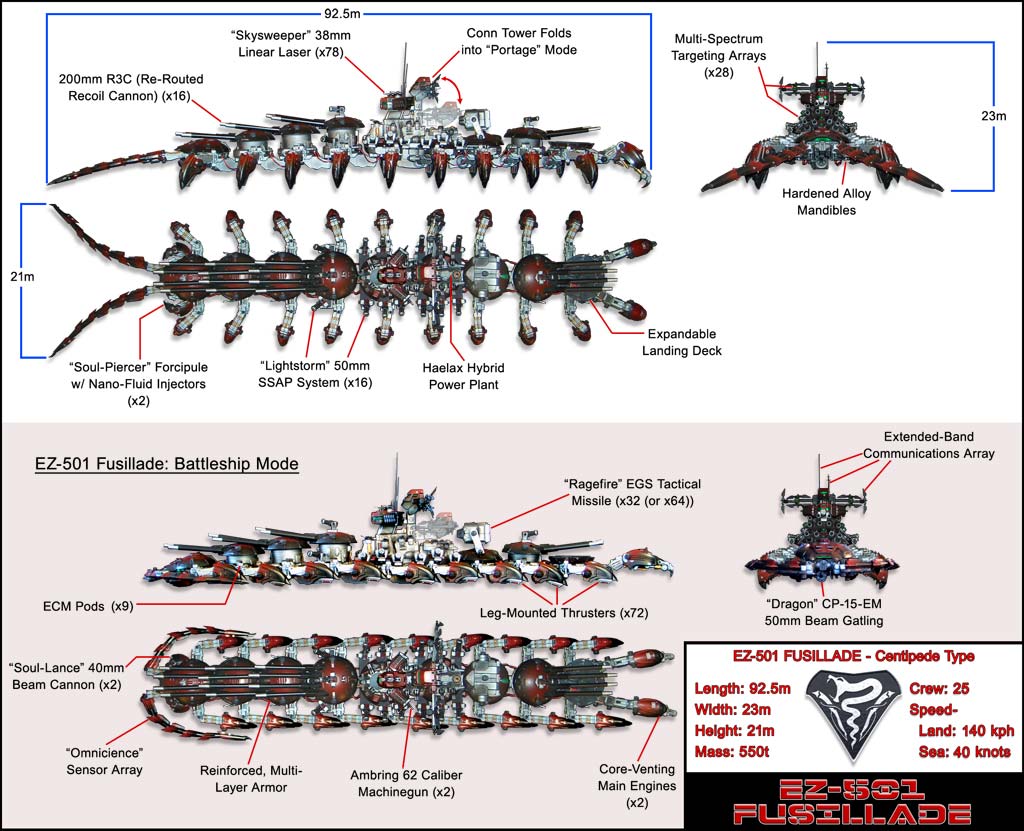
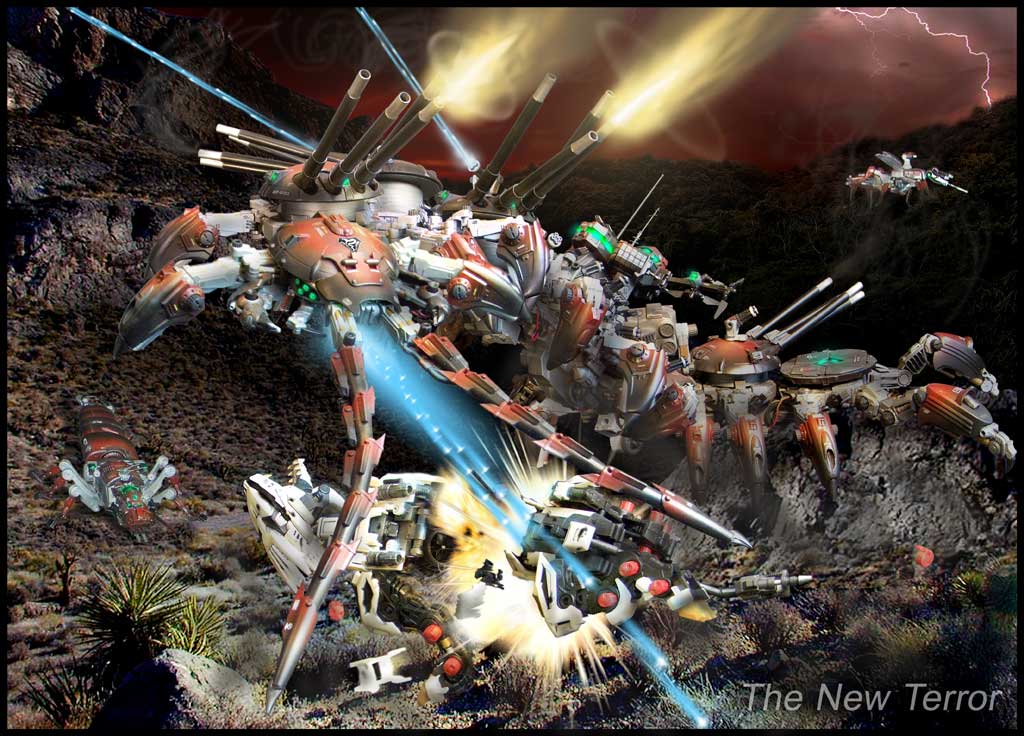
CAPABILITIES
The most obvious aspects of the EZ-501 are those immediately available through the observation of its chassis. It has a disclosed flank speed of 75 kilometers per hour over land but a classified speed of 140 kilometers per hour. It is also capable of tackling incredibly rough terrain with little impact on speed. With its Killer Dome roots intact, the Fusillade is a capable sea floor crawler, able to submerge to 400 fathoms and maintain a speed of 15 knots. Another classified statistic is that it is designed to align and lock its segments and legs to take on the form of a conventional warship. Using a series of booster jets located in the legs, it is capable of achieving 40 knots as a surface vessel or submerged as a submarine.
Fusillade is extremely strong due to its centipede design. On firm enough ground, the rear three segments can grip the earth and raise the remaining six into the air. This is a daunting sight to the pilot of any Zoid, but far more terrifying is the Fusillade’s ability to leverage this strength with horrific physical attacks. It can slash and crush multiple opponents by sweeping through them in a massive arc (up to 140 meters in diameter), or pick up and crush Zoids up to 350 tons in its 6 pairs of free legs. It may also rip enemies apart with a pair of forcipule and mandibles that can open wider than most Zoid chassis, piercing through all but the toughest armor and even cutting ligers in half.
The EZ-501 has the most powerful sensory and communications system of any Zoid in service. The antennae provide virtually unlimited link-up capability with any Zenevas unit within 1,000 kilometers and can identify not only powered down Zoids but, in many cases, man-portable powered devices such as radios, energy clips and even a wrist watch. It can track more than 500 targets simultaneously and formulate attack solutions for any Zenebas weapon system in the theater, compensating for speed, maneuverability, terrain and in some cases known ECM capabilities. The conning tower array provides ample communication power for all allied units and is capable of match-hacking all but the highest security enemy frequencies.
HISTORY
When the Emperor made the decision to enact the Purification of Zi, it was understood that there would be special requirements to take and hold vast swaths of land quickly. A Zoid was required that could conquer any terrain at speed; move enough artillery to break any resistance and preserve a command structure for extended lengths of time. The search began for a feral Zoid platform that could fulfill this weighty role, but no natural Zoid could bring exactly the elements the Empire would require.
Omnipotent Armor Systems, a powerful corporation that had acquired the rights to various heavy ground units including the Killer Dome, Macurtis and Rhimos designs, devised a plan to merge multiple Zoids into a single, potent entity. The requirements precluded that all the same units would be needed to maintain cerebral-chassis linking, a new and experimental technology that could give one CPU control over multiple identical bodies. Low AI capabilities would prevent CPU conflicts, a modular body would ease physical transition and the final design would require great strength to bear the weight of the planned ordinance and armor. With thousands of Killer Domes now rendered ineffective by the receded oceans and superior sea-going units, they were a natural solution.
It took two years to develop the concept into the first prototype, and the last obstacle was removed with the replacement of the primary Killer Dome’s CPU with an entirely new unit based on the Death Stinger architecture. This was melded with the most advanced feral arthropod Zoid core that could be found. The prototype EZ-501 Fusillade was born. In its preliminary trial, General Vaelus Haeger was quoted as describing its performance as, “staggering in every way.”
CREW STATIONS
There are 25 crew stations within the Fusillade with one station reserved for the flight officer of any reconnaissance Zoid assigned to the unit. This spare chamber is also used to board the personnel from another position in order to make room for VIP visitors during inspections or special missions.
1) Pilot – #3 in command, responsible for actually driving the Zoid into battle and has direct control over the mandibles and CP-15-EM Gatling cannon.
2) TSAS (Tactical Sensory Array Specialist) – controls main antennae to act as navigator, responsible for situational awareness, distant target acquisition and tracking.
3, 4, 5, 6, 7, 8, 17, 18) R3C Gunners – controls the 200mm primary artillery cannons
19, 20, 21, 24, 25) AOE (Artillery & Ordinance Engineers) – ensure magazines, loaders, mechanics, power and signal flow are all functioning at optimum capacity.
9) Starboard IWS (Interception Weapon Station) – assigns control of right side 50mm guns
10) Starboard DWS (Defense Weapon Station) – assigns control of right side 38mm guns
11) FCO (Fire Control Officer) – #2 in command, organizes and executes bombardment actions
12) Port DWS (Defense Weapon Station) – assigns control of left side 38mm guns
13) Port IWS (Interception Weapon Station) – assigns control of left side 50mm guns
14) ZCO (Zoid Commanding Officer) - #1 in command, possibly even for the entire theater
15) AO-TS (Aerial Ordinance Tracking Station) – functions as missile system gunner
16) ATCO (Air Traffic Control Officer) – tracks and guides allied or Fusillade-affiliated aerial units (usually an EMZ-004 Bloodstrike or tactical pods)
22) PSE (Power System Engineer) – monitors, maintains and repairs power plant and power distribution systems. Below main con tower, forward station.
23) ESE (Energy Shielding Engineer) – monitors, maintains and repairs energy shield systems. Below main con tower, aft station.
26) R4FE (Reserved for Flight Engineer) – bunk set aside for recon Zoid pilot when aboard.
DEFENSES
Killer domes weigh 38 tons and carry almost 10 tons of armor. Reconfigured into nine segments with improved load-bearing capabilities, this aspect allows the Fusillade to carry over 100 tons of reinforced, multi-layer armor. The head, in particular, has triple redundant armor protection and can withstand a direct hit from a CP-10. ECM pods are placed within each body segment and each limb of the EZ-501, reducing it signature to a pitiful scattering of armored infantry units. To protect the command structure and sensitive parts from kinetic damage, the Fusillade is armed with a staggering number of interception gun systems that can effectively annihilate 10 incoming projectiles per second… ceaselessly.
Every Fusillade is coupled with at least one aerial support Zoid, usually the EMZ-004 Bloodstrike which was developed specifically for this role. This provides phenomenal early warning and allows the Fusillade to strike back, even with indirect firepower, at anything the targeting Zoid can see. Finally, every segment is equipped with a light energy field generator. Alone, each of these may cause a beam to slide off the hull armor or reduce damage, but with all nine generators working together the entire EZ-501 is encapsulated in a field of slippery energy that slides most energy attacks around it. Because the primary guns of the Fusillade are projectile weapons, they may fire freely even when the shields are in place, and these require little power to continue their bombardment.
ARMAMENT
Despite its size and fearsome power, the EZ-501 Fusillade is not a super weapon. It carries a huge arsenal, yet this is comprised entirely of conventional weapons. From howitzers and cyclic cannons to missiles and lasers, it wields no advanced particle, fusion, gravity or other unique or classified weapons. It can, however, unleash a terrifying rain of heavy ordinance over a daunting area and fill the sky with enough defensive firepower to tear apart virtually anything in the air.
200mm R3C (Re-Routed Recoil Cannon) (x16) – mounted in 4 batteries of 4 in 240º arcs
The deathblow punch of the EZ-501, each gun is capable of sustaining a withering rate of fire (1 round per 5 seconds, indefinitely or bursts of 1 round per second for 10 seconds, requiring 30 seconds of forced cooling between bursts). Altogether, a 10-second burst from all 16 guns results in a hail of 160 rounds in 10 seconds. The R3C fires a self-guided V-LAP (Velocity-enhanced Long-range Artillery Projectile) with a range of 60 kilometers, striking within .5 meters of target center. Rather than attempting a combination of extended range and high explosive damage, the RRC round is designed for ultimate penetration of the target with a rather mild explosive load. Each cannon is equipped with an automated-feed magazine holding 50 rounds of ammunition, limiting the Fusillade’s long term field applications without support units. The Fusillade may engage in a maneuver known as an “ammo dump” and empty its magazines at a rate of 1 shot per 4 seconds. At this rate, the EZ-501 can strike a single target with 400 rounds in 1.6 minutes (a combined fire rate of 4 rounds per second for 16 guns)!
“Lightstorm” 50mm SSAP System (x16) – lateral con tower and turret mounts, variable arcs
Modified 4-barrel SSAP (Solid-State Accelerated-Proton) System is similar to a beam Vulcan cannon except that all four barrels fire simultaneously. While this limits the duration of the system to extremely short bursts of firepower (no more than 3 seconds) it sends four times the firepower against the target. There are 16 of these weapons mounted on the Fusillade, primarily for defense against incoming projectiles. However, they are quite capable of tearing soft targets apart at up to 1 kilometer away and at ranges closer than 500 meters up to 11 guns can combine fire to devastate even heavily armored targets.
“Skysweeper” 38mm Linear Laser (x78) – mounted 3 per 26 dorsal & bridge turrets, variable arcs
Similar to those mounted on Seismosaurus but upgraded to triple-barrel units, these light yet long range guns are used to deter aerial units while the Lightstorm SSAP’s direct their firepower on incoming projectiles and missiles. The Skysweepers have a range just over 2 kilometers. Each turret staggers the fire of the three barrels within a quarter second, allowing the first shot to strike a point on the target and following it up immediately with a second and third beam at the same location, offering a higher probability of armor penetration.
“Ragefire” EGS Tactical Missile (x32 (or x64 for short range rounds)) – mounted on dorsal turret #4, 360º arcs
These EGS (Enhanced-Guidance System) missiles are loaded into a modified, permanently-mounted twin CP-15 launch system. They are variable payload missiles but the standard load is 16 each APEX (Armor-Piercing High Explosive) or MMD (Multi-Munitions Distribution) warheads. These give the Fusillade a range of 120 kilometers with pinpoint accuracy, or with the ability to damage dozens of lighter enemy units simultaneously with the MMD. A short range weapon variant delivers identical damage at half the range, but two rounds can be stored per tube, doubling the Fusillade’s missile capacity to 64 missiles.
“Dragon” CP-15-EM, 50mm Assault Beam Gatling (x1) – head mounted, forward arc, fixed
Built almost as an afterthought, the CP-15 was the standard assault Gatling cannon mounted on various medium to heavy Zoids. The EM variant, however, is fixed directly to the chassis of the Fusillade and has its power piped directly from the foremost power core, giving it almost unlimited firepower. It was included in the final draft of the EZ-504 design in order to augment its close-in combat abilities while both giving the Fusillade an anti-Zoid weapon not reliant on ammunition and modifying the gun’s placement to allow the terrible jaws to be used unhindered. With a staggering 150 beam-per-second fire rate, the CP-15-EM can saw a 60 ton Zoid in half with one concentrated burst and do so at a range of up to 2 kilometers away.
“Soul-Lance” 40mm Beam Cannon (x2) – head mounted, under forcipule cowling
These weapons are designed to work in tandem but are quite capable on their own. They use a variable pulse of accelerated particles that begins exceptionally fast to instantly wear a surface and then slows that pulse into harder hitting accelerated matter. The result is a beam that is designed to pierce armor and incise protected components. While it doesn’t make a large hole, it will pass straight through a Command Wolf’s armor and strike its core.
“Soul-Piercer” Forcipule (x2) – head mounted, forward arc, fixed
Folding around the mouth parts and armoring the lower portion of the head, the forcipule are extremely powerful weapons for gripping enemies and piercing the heaviest armor. They use a form of particle beam to slice through the molecular structure of armor and components, then they inject a viscous fluid into the wound. This fluid is a vehicle for millions of nanites that dig into and disassemble internal components on contact; gaskets, wiring, fiber optics, cables. Depending on the size of the victim, the machine will simply fall apart from a few seconds to a matter of minutes. If damage compromises the nanite delivery system, a failsafe vaporizes the weapon system with an internal plasma burst that destroys the nanites, preventing severe damage to the Fusillade itself.
Hardened Alloy Mandibles (x2) – head mounted, forward arc, fixed
Caught by the forcipule, an enemy unit is then drawn into the jaws of the Fusillade. The large mandibles tear into armor and structure while hardened teeth shred systems and structures. If the bite is done correctly, the Fusillade may also fire the Dragon beam Gatling point blank.
Ambring 62 Caliber Machinegun (x2) – bridge mounted, rear-lateral arc, 90º elevation
A pair of these burst firing weapons are mounted on either side of the main bridge structure. They are considered backup weapons only; one more deterrent to lighter Zoids on the ground or in the air that might assume they are safe from the Fusillade’s heavy cannons.

SUMMARY
The EZ-501 Fusillade is first and foremost a heavy artillery bombardment platform. It is designed to allow the rapid deployment of direct and indirect Zoid-stopping power as well as maintain the personnel and command structure required to employ it. These requirements are fulfilled by a fast, heavy chassis the supports heavy artillery weapons, target acquisition and tracking hardware as well as defensive weapons to ensure long term survival. It is considered an extreme threat and should be considered as a prime target within any theater of operation in which it appears.
For the Empire the Fusillade has several strong disadvantages that it must weigh when deploying the system. The most obvious is the inclusive risk factor, A.K.A. the “putting all your eggs in one basket” factor. A Fusillade represents the definitive bombardment, command, communications and defensive platform in virtually any force, meaning that force will lose significant advantages in every facet if the Fusillade is destroyed. Secondarily, it required a steady stream of support, mostly in the form of ammunition. The R3C main guns and Ragefire turret can chew through an entire ammo payload in minutes, leaving the EZ-501 as a purely defensive communications platform until resupply is effected. Thirdly, due to supplies and advanced technologies, the Fusillade is expensive to manufacture and maintain. For the price of a single Fusillade, the Empire can field four Iron Kong PKs
THE BUILD
Here, then, is the larger portion of this page. This Zoid far outweighed any modeling attempt I had yet attempted; it was literally the equivalent of constructing 10 custom Zoid models simultaneously. It also represents a sizable list of firsts: 1) Fusillade is my first attempt at building any model of this scale... that is, a model 1.2 meters long (almost 4 feet long!) 2) It was my first attempt at wiring a Zoid for light. 3) This was the first time I had designed all interior graphics in exhaustive detail (every control surface is depicted on custom printed labels, not mere paint dots). 4) It is the most articulate model I have ever attempted, with more than ten times the number of moving parts found on Gallant Mariner or Paladin. 5) Fusillade is the first Zoid I have designed with two distinct operating modes; a land-based centipede mode and a maritime battleship mode. 6) It is the first time I have employed cloth fabric in a model; the weather seals for the primary cannons are all custom cloth skirts.
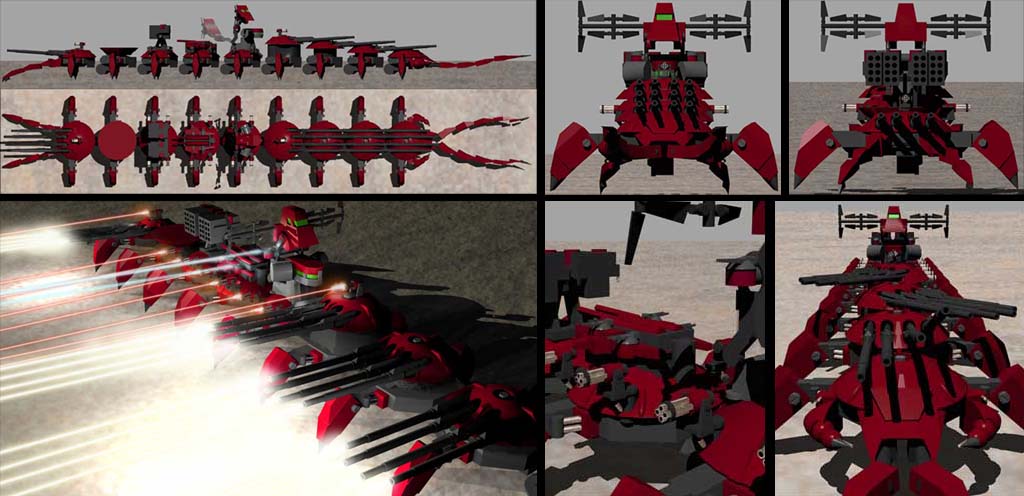
HOW NIGHTMARES BEGIN
There were three main elements that inspired me to build the Fusillade: 1) I won a lot of 10 Killer Domes! This led to the question, what could I build with 10 identical, round Zoids with heavy claws and lots of legs? 2) I have always found insects, arachnids and arthropods fascinating... and the more I learn about them the more daunting they seem. The centipede is a terrifying form, an incredible hunter, lightning fast, armored and viscous. It is also made up of many identical, round segments. Finally, the question became, how shall I style a centipede Zoid? It was the domes themselves that gave me the idea for gun turrets... 3) my admiration for the engineering and the mission of the powerful battleship rose to the top. These three elements established the final concept, respectively representing 1) available parts, 2) desired animal form and 3) the mission role of the Zoid.
3D VISUALIZATION
To start such a large project I knew I couldn't just jump in. I build a model of the Killer Domes in 3D and worked on their assembly. The first thing I noted was the legs that were included with the Killer Domes would never do; it would look like a terriffic millipede, but it lacked the power and strength I desired. The claws had to be converted! From that point I decided to use ballpoint pens for cannons (because where else would I find 16 identical cannons for $2?) I had the remains of the Kreep and Molga I used to make Angstmorder, and I had known since that day that they would be made into jaws for something... the 'pede was perfect! I also realized I had 20 Gatling guns to use! I built one Dome and decided to use 16 Gatlings for air defense guns, like the old World War 2 ships. I threw the CP-15 missile pods onto the model early on, but you will notice the lack of the Gatling cannon under the head... that was an afterthought. Finally, I added the only items for a bridge I could find at the time; a spare Elephander head and a HI-1000 motor left over from my killing a Black Rhimos. The antennae off the bridge were inspired by the Space Battleship Yamato, as was the idea of Fusillade having a functional battleship mode. The spare Killer Dome eyes on the sprue trees made up the arrays.

THE COLORS
I struggled with the colors for the Fusillade from the beginning, and even up to the day I primed it. You will notice the original colors were those of the Iron Kong PK and what I call the "Red & Black" series. Tsunami was colored for the "Black & Red" series, and I know that scheme hurt that entry's acceptance. I wanted a new look for my future Zenebas forces, but something that honored the classic line. I decided to merge the OJR "Silver & Maroon" and the OJR "Black & Red"... the result was a dark, dull silver body with armor that was dark red radiating to black at the edges. The painting technique was similar to that used on Dark Emperor, and it turned out as I hoped it would! The only change I would consider at this point would be to add a few more dark pieces along the silver superstructure. The above string of images was created as I sorted the colors out to see how they would look in final. I have decided to use these schemes to represent different tribes in my world of Zi during the Age of War.
ANATOMY OF A FUSILLADE
And so it comes to the features of this build. I will take you on a tour from the front of the Fusillade to the back. Hopefully this won't eat too much bandwidth or bore the heck out of you, but I have had many requests in the past for more build details...
Here we go!


BIOLOGY, TECHNOLOGY ... AND PEN CAPS
Centipedes have long, very flexible antennae, which are also well armored. It was vital that I find a way to build a pair of antennae that not only looked the part and looked cool... they had to fit a bug almost a full meter long! After digging through all of my parts and seeing I had nothing to use, I also made a hard decision... I would NOT resort to using a pair of Seismosaurus tails. That would have been an easy fix, but too thick and already too overused by other Zoiders. I finally settled on something I had an abundance of... pen caps! I used 16 pens to create the guns, but it was a box of 32. I stuck the caps together to get them out of my way, then realized how they looked. I cut an opening out of each cap's open end, then sanded the closed end round to create a hinge joint. You can see the metal pins holding them together in the images below. Those metal pins came from the leftover gears I ended up with after I hollowed out the Killer Dome motors (necessary to make the turrets and legs work). A hole had to be drilled through both ends of every cap, then the pins pushed through with pliers.
SUBTLE STRUCTURES FORCE FEARFUL DESIGN DIFFICULTIES
Centipedes have an interesting and challenging anatomy, but many aspects of focused in the head (let's face it, the rest is segment with legs... repeat until you run out of segments). Aside from the flat armored shape (which was made easily with the Killer Dome) there were antennae supports, mandibles, forcipules, and eyes to create. Of these, as with the Dark Emperor scorpion, the mouthparts and eyes were complicated structures... and for me, they had to be at least reasonably anatomically correct.

ECHOES OF DREADNOUGHTS
The entire intent of this build was to honor in form and function those mighty warships of the past and draw them into the future of Zi. One of the first aspects of my design was to determine how to build the turrets. I had considered 2, 3, and finally 4 cannon batteries. 2 guns looked good, but sparse. 3 guns simply would not work; the curvature of the Killer Dome shells made the center barrel jut up too far and the mechanisms of that gun would be too close to the support structure inside the top of the dome. That could be cut out with a lot of work, but it gave stability and mobility to the turret. 4 guns it had to be.

FILL THE AIR WITH FIRE!
Modern warships almost universally mount a few CWIS (Close-in Weapon System) defense guns; usually high-velocity, 6-barrel 20mm Vulcan cannons. The WW2 era ships had racks of secondary cannon and anti-aircraft batteries for defense. Fusillade has racks and rows of 4-barrel Gatling cannons and three-gun defense turrets. All told, the EZ-501 is defended by 42 gun emplacements!

YOU HAVE THE CONN
It was inspired by looking at the abandoned motor left over from Black Rhimos when he gave his life for Dark Emperor. I popped it open and took out the inner workings, set the case back together and looked at it. It formed a long room surrounded by windows. It would work! I already knew I wanted to use the Elephander head as the command conn, but adding a full blown bridge would be great. This piece of Fusillade really does notch itself up with my better modeling achievements.

MANY HAPPY REPORTS
Modern warships rely almost entirely on missiles for attack and defense over distances, and Fusillade must have his own arsenal to extend his reach. Originally though of as a stationary missile tower (inspired by the "smokestack missile tower" on the Space Battleship Yamato), it was soon clear that this, too, would be turreted.

FUSILLADE TOUCHDOWN!
What started out as a simple, overturned Killer Dome shell with a lid on it became a marvelous addition to the final build. To honor the battleship roots, I had decided to make a landing platform for a recon Zoid of some kind that could assist the larger Fusillade. After the platform took shape, it expanded into quite a wonderful piece.




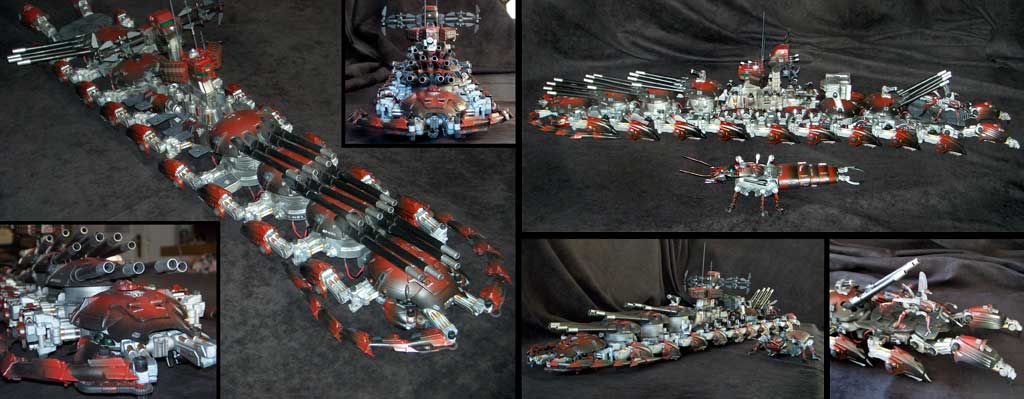


ROOTS & TIPS
To attach the antennae to the head, I had to build a support structure that would hold them out from under the armor plating on the forehead. I glued two pairs of Killer Dome lags together to create a solid structure that was large and strong enough to carry the weight of the antennae. The closest caps to the head rest upon structures taken from a spare Gorhecks. If you look at these parts, by the way, you will notice they are not symmetrical! I had to do some minor surgery to get them to look alike and function the same. The pen tips wouldn't work to end the antennae, either. I took another pair of Killer Dome feet to create the claw-tips. To make the caps closer to the head seem larger and taper the antennae toward the tips, I used spare Seismosaurus cannons on the outside as sensor modules, then up top I glued the clips I had cut from the caps in order to joint them together. In the end I was very satisfied with the antennae! They look menacing, functional and well proportioned.




A JOURNEY OF MANY STEPS
Centipedes have legs. They have between 18 and 210 pairs of them. My poor 'pede would get short changed and only have 10 pairs. Originally I gave a fleeting thought to using the 72 that came with the Killer Domes, but they were absurdly small and unintimidating (though they would work well for a millipede custom). For the piece of gear I was creating, I would need something more powerful and more terrifying.
BASIC HEAD STRUCTURES
From left to right, above, you can see the progression of the head concept. 1) Originally it was known that Molga tails would provide the forcipules, or really nasty foreleg-fangs that pierce and destroy prey; the head armor would perfect their shapes, but the structures were hollow. I mounted the Molga parts on Black Rhimos pieces that normally moved the rhino's legs. I knew from the start, also, that a set of Killer Dome legs would be used for the smaller mandibles. The holes beneath the Dome's body provided me with perfect points to attach these and hinge them, making sure they were secure enough by drilling through the bottom of the Dome's shell. 2) here you can see two abandoned structures more clearly; the original plan was to mount the antennae on modified Elephander tusks. Behind these you can see two viscous-looking upturned teeth... originally, Fusillade was to have a lower jaw. 3) The jaw was removed after I propped the remains of my CP-15 Gatling cannon under the Deathpion hood armor. Understand that this gun is missing the end piece with the barrel details; that resides in Dark Emperor's tail! 4) The final solution was to suspend the antennae from the front of the Dome's body by creating an articulating base, which you will see below.
SEATING FOR TWO
I had decided that the only way to make the head look correct for a centipede was to turn the Dome around. Killer Dome has much more mass behind the claws, and I realized that I would have to flip that piece around for several reasons; 1) to make the head extend past the foremost legs, 2) to provide the placement of the mouthparts, and 3) because the Dome's awkward engine/wheel system needed to be to the rear in order to provide articulation. This created a new problem... the pilot seat was now facing to the rear! To rectify this took a LOT more effort than I liked. I cut away the large vent that was now facing forward in order to put a pilot seat there. For the chair I took the scout pod from the dead Rhimos and cut off the small engines and all protrusions, reducing it to a simple seat. This fit perfectly in the hole where the grate was. The antennae mount was created with Gojulas and Giga pieces, then capped with a heavy grate made from an old Mammoth leg piece. It came together very well, I feel.

SWING THIS, ROTATE THAT
First, I waited until the very last to place the eyes. Centipedes can have no eyes, or multiple pairs or clusters. The most common pictures I found had a cluster of 4 eyes on either side of the head near the base of the antennae. I decided that, if I had time, I might try to illuminate them (which I had never done on a Zoid before). This meant that I had to drill 8 holes through the head structure, cut 8 pieces of clear green sprue plastic, buff each smooth, and glue them in the sockets. While doing this, it occurred to me there was no way I could recover the model if I messed it up... there were no Domes left! In image 1) you see the eyes peeking out from under their armor. I still can't believe that worked. This frame also shows how the mandibles snap inside of the huge forcipules. 2) One problem with Killer Dome legs is that they make perfect mandibles in scale with the Zoid... the bad part is that they don't articulate and are molded hallow, so they don't fold completely out of the way to allow the forcipules to bite together. I found that the mandibles could swing backward and that they lock perfectly between the chassis and the forcipule hinge joints! In this position the forcipules can reach all the way around and just touch... right in front of those four nasty teeth you can see at the top of the frame. 3) and 4) show a feature on the Gatling that is difficult to see in any other shot... that the end cap is actually NOT the end (I had to drill the holes) and that I ventilated it. There is a large hole bored between the barrels, solely because I've never seen this common Gatling gun feature done on another model.
HEADLIGHTS
Once I had enough of the Fusillade finished, I estimated I would have time to wire it. I started with the head... if there was one part I wanted to glow, it HAD to be the head! 2) I cut the plastic grates out from the front of the head (the back of the Killer Dome) and painted the sockets behind the eyes with bright silver, then dusted it with a layer of luminescent paint. 3) I know, someone out there is cringing at my wiring! I originally hooked up a pair of LEDs to drop just into the eye sockets, but they were not bright enough to give me the effect I really wanted... 4) so I used standard small Christmas tree lights instead. MUCH better! You can see that there was a large gap over the antennae support structure and the curvature of the lid. I intentionally designed this for the pilot's window. The green glass is cut from the transparent green cap to a stick of deodorant! (As you will see, deodorant is one of the Empire's greatest assets!)


IN NEED OF SUPPORT
For the main leg sets I was originally going to attach the claws directly to the ends of the Killer Domes' arm stubs by creating a new joint (you can see this experiment as the lowest left on the far left picture). Then I tried two different concepts using the ample number of spare crab legs. The middle pair has a joint beneath the claw; it is created from the tube of a ballpoint pen left over from my cannons. The plastic is very strong and semi-flexible. The highest of the three pairs seen at left had the round knee joint near the tip of the claw drilled completely through, the post of the claw then neatly passed through it. While this was a very slick looking model, the pen cap was easier to manufacture and if offered the Fusillade more height. To the right you can see the first 9 pairs of legs drying.
FLEXIBILITY & STRENGTH
Upon building the knee I knew the bigger challenge was the hip. There would be 18 hip joints, and they had to be joint... leaving them static looked ridiculous. The legs of the Fusillade are held in place by makeshift joints that for a "C" by using pieces from the original Dome leg supports. Each support had to be cut into two smaller pieces, which were then glued to the upper and lower halves of the old crab shoulders. This allowed the legs to sweep completely to the rear and quite a ways forward. With the knee able to bend well over in a crouch and extend fully, the concept of the battleship mode was solidified.



CANNON MECHANICS
The cannons could not be static. I was unprepared for the amount of work it would take to build them. Image 1) shows the components required to build the articulated guns. That rod at the top is a length of CAT-5 Ethernet cable, those black things on the cable are the support rings that once provided the joints to the large claws of the Killer Domes. If you note the before and after images, the older shots have two rings protruding from each leg near the knee. Every on of these had to be removed, slid onto the cable, then filed and sanded smooth. If they varied at all the guns would skew. Each of the 16 ballpoint pens needed to be cut short, the open end rounded for articulation and the small, closed end had to be drilled. The cap was sliced down to hold the weather seal in place. 2) a pair of plastic articulation rings formed the locks to glue to the deck within each battery. The Ethernet cable was strung between them (the only articulation I could find that would work snugly and without breakage). Through this was passed a polystyrene tube for strength. Finally a steel straight pin was drilled through the entire assembly; this was then slid into the pen which was filled with a LOT of Loc Tite glue, giving much greater strength and leverage to the barrel.
ON PINS & NEEDLES
Only after I glued down the first articulations would I know if this stunt would work. Because of small variations in the holes cut in the armor, the joints had to be glued in place inside the battery housings and each floor and its armored shell etched with a number so I could keep them together.
WEATHER SEALS
The details of the turrets would be the second-to-last thing I did; after the targeting sites were glued on, after the rear hatches were installed, after the labels were put on... if the weather seals did not work, Fusillade's turrets would look terrible; the gaping holes had to be filled. I purchased a very thin, opaque cloth and cut 16 funnels from it. These were then glued to the barrels (seen in photo 1) to the left). Once they were dry, the front of these skirts was glued down to the deck. Before the armor could be placed back on the turret, glue was applied above the gun ports. 2) Tweezers are used to set the glue inside the ports... the weather seals have just become a hinge to the entire turret assembly! You'll see why this was critical below. 3) the trimmed pen caps were sanded out and slid down the barrels, closing the weather seals and adding a heavy, powerful looking support structure to the cannons.

INNER BEAUTY
Within each turret are a few details you won't even see... unless you partially disassemble them. 1) Here you can see that there are two pilot seats per turret. Each is made from a nylon R/C airplane aileron hinge and a rubber cap sliced in half three times. The seats fold down when not in use. 2) Our gunners take their positions... 3) and the turret is mounted to the tower. Note the Blox rubber joint on the post between the seats. To snug the turret into place, that joint must be pulled down with tweezers while the back of the turret is propped open (remember, the weather seals prevent the armor from being removed). This is also the only way to place the pilots. Note, also, that the towers the turrets are mounted atop are cut from hair spray caps. These had a wavy pattern that I liked because it added some subtle texture details. Each cap is cut to a different height, and is adorned with small model pieces for detail. As a tribute to the old ships, each has a pair of 10-inch gun batteries to act as ECM pods. Also, there is real copper cabling found on the backs of tower #2 and tower #3, seen here. 4) Finally, the hatch is designed to articulate with rubber handles cut from a Gojulas rubber bolt. You cannot place the pilots in the seats through the hatches, or even see them without a small flashlight, but it's great to know that they're in there!


TRIPLE-THREAT
As I was building Fusillade I was given an opportunity to get a Seismosaurus carcass cheap (thanks, Darth Daniel!) This gave me a few more guns to add to Fusillade that would enhance his WW2 battleship image. I was about to mount these guns "as is" but decided that they, too, must be customized. I clipped the barrels from one third of the guns and glued them into the whole cannons to create a set of 3-barrel gun turrets. Personally, I think they turned out stunningly well!
CWIS... TIMES 16!
Even on my original computer model you can see that there are 16 CWIS cannons built from the Killer Dome weapons. These little suckers took more than 10 hours to design and build. 1) Each system is comprised of the two gun parts from Dome's claws, 2 pieces cut from Dome's leg supports, 1 large rubber cap (drilled through and drilled out), 1 gear from part of the Killer Dome's engine, 1 metal post from the gear, 1 piece of sheet styrene and 2 small wires pulled from the CAT-5 cable. 2) The steel post slides into the Gatling barrels and into the gear (not too deep!), which is glued to the bolt. The leg supports are trimmed and face each other, post-to-post. These are glued within and threaded with the wires for strength... assembled INSIDE the bolt (don't get the parts stuck!) The styrene creates a base for strength and to glue to the Gatling mount. Not pictured here (I knew I would forget something!) is a small styrene tube... this is glued to the bottom of the mount in order to create a swivel on Fusillade's deck. 3) In all there are 16 gun systems... each one can elevate and lower snugly, and rotate in place on the deck.
OUTRIGGER GUN DECKS
An old video tape yielded something special... diamond plate decking! I carved the tape case up and formed decks that hung off the sides of the smooth segment armor. These give each CWIS at least a 180-degree arc of fire (they can also shoot at a 45-degree decline). All around the command structure I mounted the triple-gun turrets.
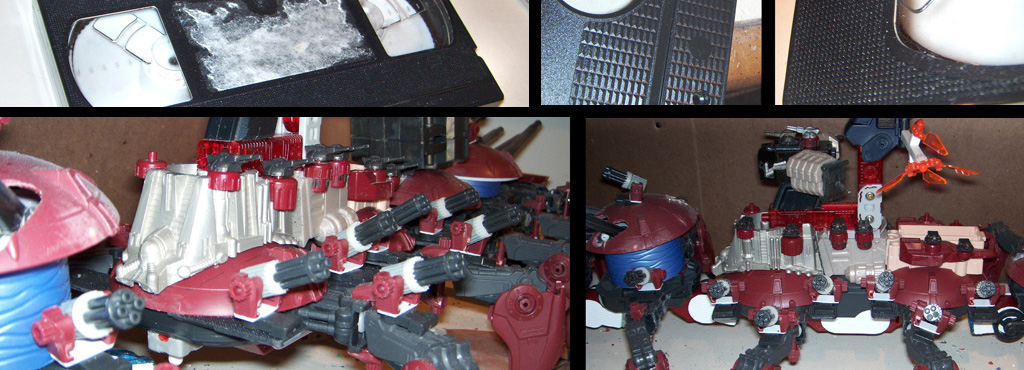


OMNIPEDS; THE LAST LEG
In laymen's terms, "omniped" simply means, "the final legs". Centipedes have two extra long legs at their back ends that almost look like rear-facing antennae. These are strong and aid in their mobility, agility, and, in some cases, they give rear attack power. Fusillade needed some terrible-looking omnipeds! 1) The first task was to create some rear-facing joints in the final Killer Dome so they could be mounted. I cut the spare Seismosaurus' purple Blox mounts in half and then cut openings in the chassis and glued them securely inside (pic #2). The omnipeds are more complicated than the other legs; 50% longer, more articulate and built from 7 different models! The main structures are Gojulas Giga arms, the hallows filled in with Killer Dome leg hydraulics and a spare gear at the knee. The black Dome claws were used as the reversed second knee joint and a Gojulas stabilizer extended its reach. The leg ends with a wicked claw, filled and smoothed with styrene and putty, thanks to Dome again. In the last two pictures you see a feature I really fell in love with; that is a functioning hydraulic piston. The hinge on the left is the same nylon aircraft hinge used to make the gunner seats, the right side is from an SD Gundam. The cylinder is a styrene tube capped and smoothed with putty. The piston is a paneling nail.
GETTING A LEG UP
After the omnipeds were finally built it was time to detail them. Large hydraulics were added from Aerosaurer, but they would not look right without my Dremmil. Each of the "simple" parts had a custom pin made to fill one hole and a trimmed and fitted piece to cap the other. In picture 3) you'll see the effect makes the system look complete and secured to the leg. 4) demonstrates the power of Speed Stick! Two deodorant caps were carved up into leg armor, then detailed with towers from Hoth and pen caps.

THE FUSILLADE CORE SEGMENT
The bridge cannot be described without a note or two on the core segment. Due to the manner in which the Killer Dome models were set (they face each other, from head to tail) and due to the requirement of a solid foundation to build the command structure un, the 5th and 6th segments were fused. Not only did I glue them together, not only did I create a large core section from Death Razer's display stand, I built two engineering stations into it! Each station has a monitor built from a Gojulas neck tube support. Again, you will never see this detail unless you take the model apart... but it's there. Thee powerful Zoids died to give the Core life; as seen in picture 3), the front segment tower is a Gojulas neck, the aft structure is Diablo Tiger's battery pack (thought I got rid of it?) and joining them is an inverted Seismosaurus' chassis. The towers are upheld by Dimetra Ptera's core, which solved a design problem (the elevating command module) with style and opened the way to light the bridge. At first I considered filling in the neck structure with some details or larger cannon, but in the end I really liked how it formed an outside observation surround, seen with a soldier in picture 4.

THE BATTLE BRIDGE - PART 1
1) Here you can see my inspiration, the HI-1000 motor. 2) I propped these Seismo pieces up and decided to add them to the bridge structure to make it feel larger. 3) The gun pod feature was actually an afterthought; there is a vertical hole in th Elephander pieces I used to cap the side pods, and a gun can swivel up and down through it like an archer in an ancient castle wall. That gun is half carved up Killer Dome claw joint, half Raven Genosaurer light cannon. It actually pivots to hold the crewman in place.

THE BATTLE BRIDGE - PART 2
1) Seismo's canopy armor becomes a command chair! His neck pieces form the outrigger pod armor. 2) assembled... without windows and... 3) antennae arrays!

COMMAND TOWER FEATURES
Briefly (don't you need a break about now?) 1) This overview shot shows the relation between the main bridge and the commander's conning tower above. Note the crewman with binoculars down below in the surround. 2) With the tops off, all SIX crew members are seen! (technically 7... you can see an engineer down below decks because the cover is off of the Core). 3) A perspective of the open windows of the bridge; the communication arrays have been added to the conn. These fold forward in "portage mode". 4) Shows the back of the command conn; a pair of triple-gun defense turrets help protect from aft attacks.

COMMAND STRUCTURE - COMPLETED
1) Here you can see the glass has been installed into the conn, as well as armored vents in other opening on the motor. I decided to leave these odd shapes rather than smooth them because they really added character to the bridge. The glass, as you may have guessed, is cut-up deodorant cap. 2) The flash was a bit too bright on the raw metal, but here you can see the conn in the "command" and "portage" positions. Portage is a term for moving a ship over land, and the tower folds down to rest over the central power core when the Fusillade has a long trek through rugged terrain ahead. To protect the sensitive communications array, the arms swing in and lock just above the defense turrets. 3) Finally, the heavy-looking central power core. Two armored ventilator fans are linked by a stout catwalk, courtesy of Seismosaurus. You can also see the new Empire signet emblazoned on the hull below.


COMMAND CONSOLES
Every command surface in Fusillade is completely detailed. Images of control surfaces of various kinds were reduced to 1/72 scale and printed out at 600 DPI. On some you can see it, most it didn't turn out in photos very well, but all surfaces have both a horizontal and vertical label. From left to right: 1) pilot station, 2) main bridge, 3) command conn, 4) outrigger gunner (lower) 5) outrigger gunner, upper and rear wall.
CUSTOM LABELS
Overkill. I thought this would be a good place to show a few Easter eggs I placed in Fusillade for you! First, and one of his coolest features... if you look VERY closely at the console in the command conn, the center panel is shown above. That colorful strip is an actual screen shot from the Commodore 64 "Zoids" video game! I never did beat that game.... Anyway, you will also see highlighted the gunner targeting system (part of a Rolland sound mixing board) and the outrigger gunner side panel, seen just to the right on the #4 image under "Command Consoles" above. Those are the safety toggles from a WW2 flying fortress... seemed appropriate. ;-)


IF ONE CP-15 LOOKS GOOD...
Making a single rack system from a pair of CP-15s took some work. The support posts on either side of the double assembly are from a GenoSaurer's rifle turret, the Gatling cannon parts had to be shaved and smoothed to make room for the exhaust system. In the center image you can see I filled in the holes in the sides of the CP-15 with sheet styrene vents; the huge gaps originally there looked wrong for my purposes. I wanted the system to look solid and capable of carrying a greater payload.
GUNNERS & AIR TRAFFIC CONTROLLERS
Originally there was to be only one crewman seated behind the reshaped Black Rhimos canopy. But, through experimentation, I decided to add the upper dome for an air traffic control officer responsible for the guidance of my Bloodstrike scout mosquitos. The sequence of shots on the right half shows the seat pulled forward, tilted back, the pilot at station and the Deathpion canopy in place. I painted the blue glass with green transparent paint, but it became so dark it was hard to see the crewman. So dark, in fact, that the installed light (which shines up from the front gunner through the consol in the high seat) barely even shines through it. Due to the wiring and the width of the supports (even with the caps trimmed down) the missile turret only turns about 180-degrees.


ORIGINAL CONCEPT
Fist it was going to be simple; make the last segment as flat as possible and, if I could, light it up from underneath. I created a "jack" hinge to lift the finished landing pad and install lights if it was feasible later on. Making the simple, smooth landing surface worked well, but after I built Bloodstrike, I wanted something that fit him better.
LANDING PAD - TAKE TWO
Simply put, Bloodstrike balanced on 4 legs on the pad, so I decided to make it bigger. But a bigger pad looked wrong... so I decided to make it expandable! I cut out a second deck and installed three nylon hinges to allow three wings to unfold. They had to be shaped to allow the segment to move without striking the #5 turret, and they couldn't block the range of motion of the omnipeds. To enclose the hinges a THIRD deck had to be built between the two! I also decided to go with the lighting scheme and make it logical. When the pad is in the closed position 1) there are 4 lights in the deck forming a diamond pattern. When the deck is expanded 2) the pilot can see 3 additional lights which form a "T" pattern. In image 3) you see the lights from underneath. The lenses are trimmed and polished green sprue (thanks to a CP-2 ) and have once side coated with luminescent paint. This acts as a reflector when the lamp is on and lets the pad lights glow with it off.
And so we come to the end of the building of the EZ-501 Fusillade!
I hope you enjoyed this (very long) trip and invite you to rest a bit...
Before continuing onward!
We're not through, yet! You've met the nominee for Best Actor...
time for the supporting cast!
I'll be quick about it this time... I promise!


FUSILLADE MODEL STATISTICS & FUN FACTS!
In the end, Fusillade became more than just a large Zoid... it required the relocation of half my collection and the building of a new shelf to house it! The model is just over a meter long (3 feet 7 inches)... and I have yet to estimate how much it weighs. In 1/72nd scale, it is 92.5 meters long. In comparison, Seismosaurus measures 53.5 meters.
Fusillade has 170 gun barrels between single chamber weapons, triple-cannon turrets and Gatling cannons. Between legs and body, there are 80 hydraulic cylinders. Lighting Fusillade took more then 4 meters of wire (about 16 feet). All told, Fusillade has 223 points of articulation including legs, antennae, turrets, defense guns, scanner arrays, landing pad plates and folding gunner seats. The build took approximately 350 hours to complete... or 8.75 full 40-hour work weeks.

The Fusillade in warship mode
Grand Prize Winner
Grand Prix 2008 Custom Contest

1st Place Winner
Zoids Poison 2008 Custom Contest

FUSILLADE AI-2 PROFILE (Artificial Intelligence And Instict)
As is the trend with all latest generation Zoids, the Fusillade is a machine infused with aspects of the nature of its living, feral counterpart. It has been brought violently to the attention of both Zenevas and Helic commands that the Zoid hates everything that moves. The Fusillade has a voracious predatory nature and will readily strike at any Zoid within range, the only known exception being the Sternclaw, which is why that Zoid was outfitted as a resupply unit. The safety range is measured in a 360 arc from the center of the 6th segment, directly under the raised command tower. Anything from this point to the maximum length of the Fusillade’s antennae is at risk. An incident with an arrogant Field Colonel who demanded that he personally charge a Helic force with his Genosaurer is now used as a training film for all field personnel; he ran by his general's Fusillade within antenna range and before anyone knew what happened, the massive centipede snapped up the Genosaurer, tearing its left leg off in the process, and smashed it repeatedly to the ground while chewing tank-sized holes through it. More terrifying, the entire attack lasted only 30 seconds, and the Fusillade never even slowed from a run of 65 KPH. A clash between two Fusillades would be a very costly event for the Empire in credits, equipment and lives.








